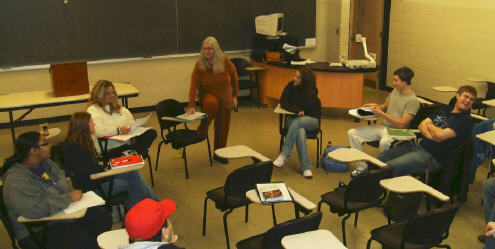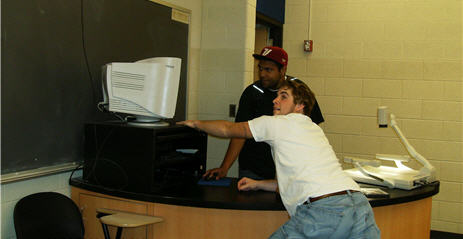When Peter and I first set out to create Debategraph, one of our fondest hopes was that the tool might help to enrich the collaborative and visual learning experience for students in schools and universities.
So it has been a joy for us this semester to be experimenting with Debategraph in classroom with Dr Sharon Chanley and her politics students at Western Illinois University—and we are tremendously grateful to Sharon and the students for having the curiosity and courage to innovate in this way.

Dr Sharon Chanley and the students of POLS 275
Sharon’s class is exploring issues of poverty and wealth inequality in the U.S. and the historical and existing public policy responses to these, and Sharon explained to us what initially captured her imagination about Debategraph:
When I first came upon the DebateGraph in my search for policy-mapping examples, I felt as if someone had designed it specifically for my approach to teaching — almost as if they had observed my discussion-based classes and then depicted them graphically. In teaching policy issues and the political processes involved, I want students to understand their complexity and the interrelatedness of the issues. DebateGraph allows me to do that in a way that two-dimensional images and discussion alone can’t. Students develop their ability to research their positions, find answers to the compelling questions, and enhance their critical thinking skills while providing me a way to comment on and complete individual assessment of their work — all important to their learning in and beyond the classroom. And, they can do it in a format that fits into their familiarity with the computer, the Internet, and their preference for the visual and importantly in a way that connects them with the rest of the world.”
During the first phase of the course Sharon and the WIU students—Brandon, Colisha, Derek, James, Jan, Jared, John, Julio, Kimberly, Patrick, Robert, and Ruth—are using Debategraph to build an informal collaborative overview of the policy domain. You can see their work in progress below—and in the next phase of the course the emphasis will shift more to deepening the map and developing a more formal structure for the material.
We have been delighted with the enthusiastic feedback from the students so far, who have taken to this new approach to learning in fine style:
I like the DebateGraph as a learning tool because it teaches us how to do in-depth research. It also allows us to open up class discussions, which allows us to hear other people’s points of view.
The DebateGraph is an excellent learning tool which helps students learn through critical thinking. I really enjoy the exercise.

I think the DebateGraph is an outstanding learning tool. It forces the student to look in-depth at a particular subject. It makes people come up with questions to see if the particular problem can be resolved.
In general, I like the graphics display as a study tool. The generation tends to like information that is bite-sized, easily accessible, and fast paced, so the point and click nature makes it very easy to find information and explore related topics which may have been otherwise overlooked.
DebateGraph is not only a great tool, but it has allowed me to gain new knowledge. It is also a great tool for students to learn about policy issues, and it is also a great tool to use.
The DebateGraph is a really cool way to debate topics so that there is a structure and much more information can be transferred.
The students’ feedback is all more gratifying given that 40% of their overall course grade is being assessed on their individual and collaborative contributions to the map. And Sharon has been employing the RSS feed, email alerts, and edit history to support her grading process—and the map Message Board to ask, and answer, student questions outside class hours.
From our perspective it has been a wonderful start, and an experience from which Peter and I are learning much too about the ways in which Debategraph can be used in the classroom; a learning experience for which we would like to give Sharon and her pioneering students a wholehearted Anglo-Australian vote of thanks.

![Reblog this post [with Zemanta]](https://img.zemanta.com/reblog_e.png?x-id=c36a0792-4b1b-4a6a-949b-0e1db9fdcf48)


